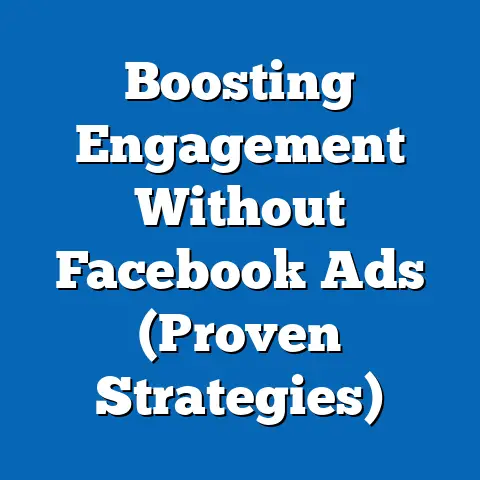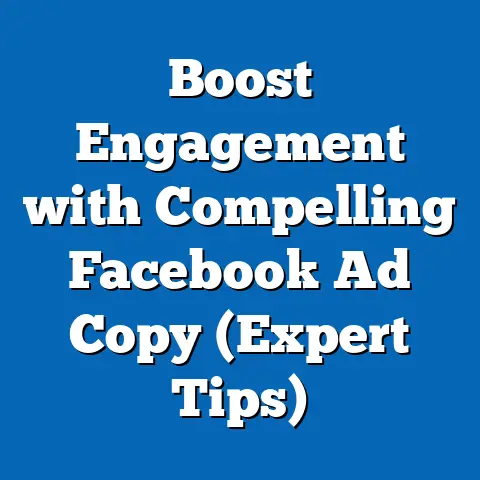Unlock Top Restaurant fb ad Segmentation (Expert Techniques)
The aroma of sizzling steaks, the laughter of children, and the clinking of glasses – these are the sounds of families creating memories over a shared meal. As someone deeply entrenched in the restaurant industry and a passionate advocate for effective digital marketing, I understand the vital role families play in the success of any eatery. Families aren’t just customers; they’re building traditions, celebrating milestones, and seeking experiences that bring them closer together. That’s why targeting them effectively through Facebook ads is so crucial.
But simply throwing up a generic “Kids Eat Free” ad and hoping for the best just won’t cut it anymore. In today’s competitive landscape, you need to be laser-focused, understanding your audience on a granular level and crafting messages that resonate with their specific needs and desires. This is where Facebook ad segmentation comes in.
Think of it like this: you wouldn’t use the same bait to catch a trout as you would a shark, would you? Similarly, you need to tailor your message to the specific “family” you’re trying to attract. Are they young parents looking for a kid-friendly atmosphere? Are they a multi-generational clan celebrating Grandma’s 80th birthday? The more specific you are, the more effective your ads will be.
Understanding Your Audience
Before you even think about creating an ad, you need to deeply understand who you’re trying to reach. We’re not just talking about “families” in a broad sense; we’re talking about specific types of families with unique needs, preferences, and dining habits.
Demographics and Psychographics
This is Marketing 101, but it’s surprising how many restaurants skip this crucial step. Demographics are the basic, quantifiable characteristics of your target audience: age, gender, income, location, education level, and family size. Psychographics, on the other hand, are the more qualitative aspects: interests, values, lifestyle, attitudes, and opinions.
For example, you might target families in a specific zip code (demographics) who are interested in healthy eating and outdoor activities (psychographics). Or, you might target families with young children (demographics) who value convenience and affordable dining options (psychographics).
The key is to combine both demographics and psychographics to create a holistic picture of your ideal family customer. Don’t just assume you know what they want; do your research!
Family Dynamics
Understanding family dynamics is critical for crafting effective ad campaigns. Are you targeting:
- Nuclear Families: Two parents and their children.
- Single-Parent Families: One parent raising children.
- Blended Families: Families with children from previous relationships.
- Multi-Generational Families: Grandparents, parents, and children living together.
- Families with Young Children: Parents with toddlers and elementary-aged kids.
- Families with Teenagers: Parents dealing with the challenges and preferences of teenagers.
Each of these family structures has different needs and priorities. For example, single-parent families might be more interested in quick, affordable meal options, while multi-generational families might be looking for venues that can accommodate large groups and offer activities for all ages.
I remember working with a local Italian restaurant that was struggling to attract families. They were running generic ads featuring pasta dishes, but they weren’t seeing the results they wanted. After digging deeper, we realized that their target audience was primarily families with young children. So, we shifted our focus to highlighting their kids’ menu, their family-friendly atmosphere (they had a small play area!), and their early-bird specials. The results were dramatic – they saw a significant increase in family bookings and a boost in overall revenue.
Creating Customer Personas
The best way to understand your audience is to create detailed customer personas. A customer persona is a fictional representation of your ideal customer, based on research and data about your existing and potential customers.
Here’s a step-by-step guide to creating family-oriented customer personas:
- Gather Data: Analyze your existing customer data (e.g., demographics, purchase history, website behavior). Talk to your staff to get their insights on the types of families who frequent your restaurant. Conduct surveys and interviews with your target audience.
- Identify Key Characteristics: Look for patterns and common traits among your target audience. What are their demographics, psychographics, family dynamics, needs, and pain points?
- Create a Fictional Profile: Give your persona a name, age, occupation, family situation, and a detailed backstory. What are their goals, values, and motivations? What are their challenges and frustrations?
- Add a Photo: Find a stock photo that represents your persona. This will help you visualize your target audience and make them feel more real.
Here are a couple of examples of family-oriented customer personas:
Persona 1: Sarah, the Busy Mom
- Age: 35
- Occupation: Marketing Manager
- Family: Married with two children (ages 4 and 7)
- Location: Suburban neighborhood
- Interests: Healthy eating, family activities, convenience
- Pain Points: Limited time, picky eaters, finding affordable dining options
- Dining Habits: Prefers quick, casual restaurants with kids’ menus and healthy choices.
Persona 2: Robert, the Family Patriarch
- Age: 65
- Occupation: Retired Accountant
- Family: Married with three adult children and six grandchildren
- Location: Rural town
- Interests: Family gatherings, traditional values, comfort food
- Pain Points: Finding venues that can accommodate large groups, catering to different dietary needs, staying within budget
- Dining Habits: Enjoys family-style restaurants with a wide variety of options and a relaxed atmosphere.
By creating these detailed customer personas, you can gain a deeper understanding of your target audience and craft Facebook ad campaigns that resonate with their specific needs and desires.
Takeaway: Understand your audience through demographics, psychographics, and family dynamics. Create detailed customer personas to guide your ad targeting and messaging.
Facebook Ad Targeting Options
Now that you have a clear understanding of your target audience, it’s time to dive into Facebook’s powerful targeting options. Facebook offers a wide range of tools to help you reach the right families, ensuring that your ads are seen by the people who are most likely to become your customers.
Core Audiences
Core Audiences are the foundation of Facebook ad targeting. They allow you to target users based on their:
- Location: Target families in a specific city, zip code, or radius around your restaurant.
- Age: Target parents within a specific age range (e.g., 25-45).
- Gender: Target both parents or focus on one gender (e.g., mothers).
- Interests: Target users who are interested in family activities, parenting, kids’ products, or specific types of cuisine.
- Behaviors: Target users who have demonstrated certain behaviors, such as traveling with children, attending family events, or purchasing kids’ products online.
- Demographics: Target users based on their education level, job title, relationship status, or parental status.
For example, you could target parents aged 25-45 who live within a 5-mile radius of your restaurant and are interested in “family restaurants” and “kids’ activities.”
Custom Audiences
Custom Audiences allow you to target users based on your own data. This is a powerful way to reach families who have already interacted with your restaurant or brand. You can create Custom Audiences from:
- Customer List: Upload a list of your existing customers’ email addresses or phone numbers. Facebook will match these to user profiles and create a Custom Audience.
- Website Traffic: Track visitors to your website using the Facebook Pixel and create a Custom Audience of people who have visited specific pages (e.g., your menu page or your online ordering page).
- App Activity: Target users who have interacted with your mobile app.
- Engagement: Target users who have engaged with your Facebook page or Instagram profile (e.g., liked your posts, watched your videos, or commented on your photos).
For example, you could create a Custom Audience of families who have dined at your restaurant in the past year and target them with a special offer or a new menu item.
Lookalike Audiences
Lookalike Audiences allow you to expand your reach by targeting users who are similar to your existing customers. Facebook will analyze your Custom Audience data and identify users who share similar demographics, interests, and behaviors.
This is a great way to reach new families who are likely to be interested in your restaurant. You can create Lookalike Audiences based on your:
- Customer List: Create a Lookalike Audience based on your best customers.
- Website Traffic: Create a Lookalike Audience based on users who have visited your website and made a purchase.
- Engagement: Create a Lookalike Audience based on users who have engaged with your Facebook page or Instagram profile.
For example, you could create a Lookalike Audience based on your existing family customers and target them with ads promoting your family-friendly atmosphere and kids’ menu.
Takeaway: Master Facebook’s targeting options, including Core Audiences, Custom Audiences, and Lookalike Audiences, to reach the right families with your ads.
Expert Techniques for Effective Segmentation
Now that you understand the basic targeting options, let’s dive into some expert techniques for effective segmentation that will take your Facebook ad campaigns to the next level.
Behavioral Targeting
Behavioral targeting allows you to reach families based on their actual behaviors and activities on Facebook. This is a powerful way to tailor your ads to their specific needs and interests.
Here are some examples of how you can leverage behavioral data:
- Recent Family Outings: Target families who have recently checked into family-friendly locations, such as amusement parks, zoos, or museums.
- Holiday Celebrations: Target families who have expressed interest in specific holidays or events, such as Christmas, Easter, or Thanksgiving.
- Purchasing Habits: Target families who have purchased kids’ products online, such as toys, clothing, or books.
- Travel Habits: Target families who have traveled with children or are planning a family vacation.
For example, if you’re running a summer BBQ special, you could target families who have recently checked into local parks or expressed interest in outdoor activities.
Event Targeting
Event targeting allows you to target families during special occasions, such as birthdays, anniversaries, or family reunions. This is a great way to promote your restaurant as a venue for these events.
Here are some examples of how you can use event targeting:
- Birthdays: Target families who have a birthday coming up and promote your birthday party packages.
- Anniversaries: Target couples who are celebrating their anniversary and promote your romantic dinner specials.
- Family Reunions: Target families who are planning a family reunion and promote your group dining options.
Facebook allows you to target users based on life events that they have shared on their profile. You can also use custom audiences to target families who have booked events at your restaurant in the past.
Seasonal Campaigns
Seasonal campaigns are a great way to appeal to families during specific times of the year. This allows you to tailor your messaging and offers to the current season and create a sense of urgency.
Here are some examples of seasonal campaigns you can run:
- Summer BBQ Specials: Promote your outdoor dining area and BBQ specials during the summer months.
- Holiday Feasts: Promote your holiday menus and catering options during the holiday season.
- Back-to-School Promotions: Offer discounts on kids’ meals and family dinners during the back-to-school season.
- Winter Comfort Food: Promote your warm, comforting dishes during the winter months.
Remember to use relevant imagery and messaging that reflects the current season.
User-Generated Content
User-generated content (UGC) is any content created by your customers, such as photos, videos, or reviews. UGC is a powerful way to build trust and credibility with potential customers.
Encourage families to share their dining experiences at your restaurant by:
- Running Contests: Host a photo contest and ask families to share their best photos of their meal.
- Offering Incentives: Offer discounts or free appetizers to families who post photos of their meal on social media.
- Featuring UGC on Your Page: Share the best UGC on your Facebook page and Instagram profile.
You can then use this UGC in your Facebook ad campaigns to showcase real families enjoying your restaurant. This is much more effective than using stock photos, as it feels more authentic and relatable.
I once worked with a family-owned pizza place that was struggling to compete with the big chains. We decided to launch a UGC campaign, encouraging customers to share photos of their families enjoying pizza night. The response was incredible! We received hundreds of photos, and we used the best ones in our Facebook ads. The ads were a huge success, driving a significant increase in sales and brand awareness.
Takeaway: Leverage behavioral targeting, event targeting, seasonal campaigns, and user-generated content to create highly targeted and engaging Facebook ad campaigns that resonate with families.
Ad Creative and Messaging
Even the most perfectly targeted ad will fail if the creative and messaging don’t resonate with your audience. You need to create ads that are visually appealing, emotionally engaging, and clearly communicate the value of your restaurant.
Visual Elements
The visual elements of your ad are the first thing that people will see, so it’s crucial to make a strong impression. Use high-quality photos and videos that showcase your restaurant’s atmosphere, food, and family-friendly environment.
Here are some tips for using visual elements effectively:
- Show Families Enjoying Meals Together: Use images and videos that feature families laughing, talking, and enjoying their meals.
- Highlight Your Kids’ Menu: Showcase your kids’ menu items and make them look appealing to children.
- Show Your Restaurant’s Atmosphere: Use images and videos that capture the ambiance and atmosphere of your restaurant.
- Use Bright and Cheerful Colors: Use colors that are associated with happiness and fun, such as yellow, orange, and green.
Avoid using stock photos that look generic or staged. Instead, try to capture authentic moments of families enjoying your restaurant.
Compelling Copy
Your ad copy should speak directly to family values and emphasize togetherness, fun, and memorable experiences. Use language that is warm, inviting, and relatable.
Here are some tips for writing compelling ad copy:
- Focus on the Benefits: Highlight the benefits of dining at your restaurant, such as creating memories, spending quality time together, and enjoying delicious food.
- Use Emotionally Engaging Language: Use words and phrases that evoke positive emotions, such as “laughter,” “joy,” “family,” and “celebration.”
- Speak to Their Needs: Address the specific needs and pain points of families, such as finding affordable dining options, catering to picky eaters, and providing a family-friendly atmosphere.
- Tell a Story: Use storytelling to connect with your audience on an emotional level. Share a story about a family who had a memorable experience at your restaurant.
For example, instead of saying “We have a kids’ menu,” you could say “Create lasting memories with your family over delicious meals from our fun and affordable kids’ menu!”
Calls-to-Action (CTAs)
Your call-to-action (CTA) should be clear, concise, and encourage families to take the next step. Use CTAs that are specific to family bookings, such as:
- “Reserve Your Family Table Today!”
- “Join Us for Family Fun Nights!”
- “Download Our Kids’ Menu!”
- “Get a Free Appetizer for Your Family!”
Make sure your CTA is visually prominent and easy to click. Use a button or a contrasting color to make it stand out.
Takeaway: Use family-friendly imagery, compelling copy, and clear calls-to-action to create Facebook ads that resonate with families and encourage them to book a table at your restaurant.
Measuring Success and Adjusting Segmentation
Creating a great ad is only half the battle. You need to track your results, analyze your data, and make adjustments to your segmentation and creative to optimize your campaigns for maximum impact.
Metrics to Monitor
Here are some key performance metrics specific to family-oriented campaigns:
- Engagement Rate: This measures how much your audience is interacting with your ads (e.g., likes, comments, shares). A high engagement rate indicates that your ads are resonating with families.
- Click-Through Rate (CTR): This measures the percentage of people who see your ad and click on it. A high CTR indicates that your ad is relevant and compelling.
- Conversion Rate: This measures the percentage of people who click on your ad and take a desired action, such as booking a table or downloading your kids’ menu. A high conversion rate indicates that your ad is effective at driving results.
- Return on Ad Spend (ROAS): This measures the revenue you generate for every dollar you spend on advertising. A high ROAS indicates that your campaigns are profitable.
- Cost Per Acquisition (CPA): This measures the cost of acquiring a new customer through your Facebook ads. A low CPA indicates that your campaigns are efficient.
Track these metrics regularly and compare them to your previous campaigns to see what’s working and what’s not.
A/B Testing
A/B testing is the process of testing different versions of your ads to see which performs best. This is a great way to optimize your segmentation, creative, and messaging.
Here are some examples of A/B tests you can run:
- Audience Segmentation: Test different audience segments to see which is most responsive to your ads.
- Ad Creative: Test different images and videos to see which is most visually appealing.
- Ad Copy: Test different headlines and body copy to see which resonates most with your audience.
- Calls-to-Action: Test different CTAs to see which drives the most conversions.
Run A/B tests regularly and track the results to see which variations are performing best. Use this data to refine your campaigns and improve your results.
Iterative Improvements
Analyzing your ad performance data is crucial for making iterative improvements to your family-focused campaigns. Don’t just set it and forget it! Continuously monitor your metrics, A/B test different variations, and refine your segmentation and creative based on the insights you gain.
Here are some tips for making iterative improvements:
- Analyze Your Data: Look for patterns and trends in your data. Which audience segments are performing best? Which ad creatives are driving the most engagement? Which CTAs are generating the most conversions?
- Identify Areas for Improvement: Based on your data, identify areas where you can improve your campaigns. Are your ads reaching the right families? Is your messaging resonating with your audience? Are your CTAs clear and compelling?
- Make Small Changes: Don’t make too many changes at once. Focus on making small, incremental improvements that are based on data.
- Track Your Results: After making changes, track your results to see if they have improved. If not, try something else.
I’ve seen firsthand how iterative improvements can transform a struggling campaign into a roaring success. It’s all about being data-driven, adaptable, and committed to continuous optimization.
Takeaway: Measure your success by monitoring key metrics, A/B testing different variations, and making iterative improvements based on the insights you gain from your family-focused campaigns.
Conclusion
Reaching families effectively on Facebook requires more than just a basic understanding of the platform. It demands a deep understanding of your audience, a mastery of Facebook’s targeting options, and a commitment to creating compelling ad creatives and messaging. By implementing the expert techniques I’ve shared in this guide, you can unlock the full potential of Facebook ad segmentation and attract more family diners to your restaurant.
Remember, families are the heart of the restaurant industry. By focusing on their needs and desires, you can build lasting relationships, boost your revenue, and create a thriving business. So, take action today! Implement these strategies, track your results, and continuously optimize your campaigns. I’m confident that you’ll see a significant increase in family bookings and a boost in overall revenue. Now go out there and make some marketing magic!






